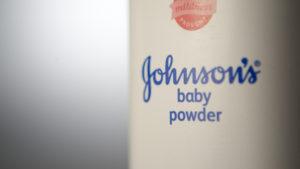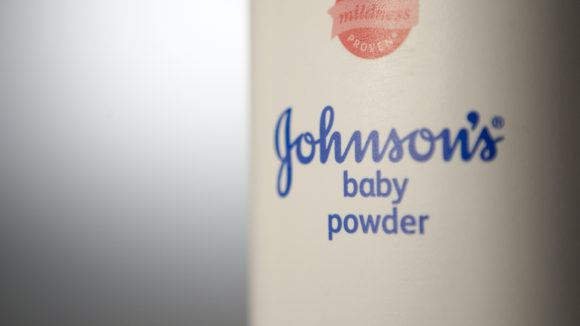Johnson & Johnson says a $417 million verdict in a talc powder cancer case should be thrown out because three jurors were excluded by fellow panelists from the decision-making process.
The three were wrongly left out of deliberations on the fourth-largest U.S. jury award of the year because they didn’t agree with the other nine jurors that baby powder was the cause of a lifelong user’s ovarian cancer, the company said in a request for a new trial.
While a plaintiff’s lawyer denies the claim and says the outcome of the Los Angeles state court trial should stand, J&J argues the August verdict was flawed in so many respects that it “cries out” for the judge’s intervention. A hearing is set for Thursday.
“The size of the verdict, contrasted with the serious deficiencies in the evidence offered at trial, raise a broader concern about runaway juries imposing staggering liability based on speculative science,” J&J said a court filing. “A concern that is amplified by the fact that this is only one of more than a thousand talc-related cased pending nationwide.”
The Los Angeles verdict was by far the largest to date over allegations the world’s largest health-care company failed to warn women about the ovarian cancer risk of its Baby Powder and Shower-to-Shower talc products. The New Brunswick, New Jersey-based company maintains that no peer-reviewed study, regulatory body or public health organization has found that talc use causes ovarian cancer.
“This verdict has gotten a great deal of attention and every court that’s going to look at it will give it considerable attention,” said Colleen O’Brien, a lawyer with Hurrell Cantrall LLP in Los Angeles who isn’t involved in the case. “There are so many places where the judge could act as the 13th juror.”
Juries sometimes get it wrong because of evidence that shouldn’t have been allowed in or because they didn’t follow the judge’s instructions, O’Brien said in a phone interview.
Judge’s Mistake
J&J argues the judge made a mistake in allowing jurors to consider that there may have been “multiple causes” of Eva Echeverria’s cancer, with exposure to talc being the most substantial one.

The 12-member panel was at one point evenly split on whether J&J was at fault and the vote shifted to 9-3 against the company when one juror suggested the multiple causes possibility, according to a post-trial statement by one of the holdouts filed in court. The panel’s majority then excluded the three holdouts from participating in discussions about the damages they would award Echeverria, according to this same juror, who was the foreperson. A second holdout gave the same version of events.
“It is established that jurors who vote against liability should still deliberate as to damages,” according to J&J. The jury’s misconduct “shows that passion and prejudice tainted the verdict.”
Plaintiff’s Lawyer
Echeverria’s lawyer, Mark Robinson, disputes the claim that any jurors were excluded from the process. Other jurors have said that all the panelists participated in the discussions about the damages, he said in a filing. How the jurors deliberated and arrived at their verdict can’t be used to second-guess the outcome, he said.
“Defendants did not lose because of something the jury did, the court did, or plaintiff’s counsel did,” Robinson said. “They lost because the evidence showed what they did.”
The foreperson says the jurors who found J&J liable went on to award $68 million in compensatory damages against the parent company and $2 million against Johnson & Johnson Consumer Inc., the unit that sells Baby Powder. That division was based on the relative market value of the companies, according to the foreperson’s declaration. The panel also awarded $340 million in punitive damages against the parent company and $7 million against the consumer products unit.
Robinson said the compensatory damages were “fair” given Echeverria’s 10-year fight with cancer that spread to her spleen, liver, kidneys, intestine, pancreas and thoracic spine.
J&J contends the damages awarded against the parent company should be thrown out because it’s a separate legal entity and there was no evidence presented at trial that the parent company was responsible for manufacturing, labeling and selling the talc products, at least not before the first studies linking talc use with ovarian cancer.
At a minimum, according to J&J, the punitive damages should be thrown out because there was no evidence presented at trial that J&J had acted with malice by either intending to cause Echeverria’s cancer or that its decision not to put a risk warning on the talc products amounted to “vile” conduct.
The case is Lloyd v. Johnson & Johnson, BC628228, California Superior Court, Los Angeles County (Los Angeles).
Related:
- Huge Verdict Upends J&J’s Talc Product Liability Defense Strategy
- J&J Seizes Supreme Court Ruling on Out-of-State Cases to Fight Talc Cancer Claims
- Johnson & Johnson Wins Trial in Missouri Talc Product Liability Lawsuits
- Missouri Jury Orders J&J to Pay $110M in Talc-Powder Trial
Topics Legislation
Was this article valuable?
Here are more articles you may enjoy.



 JPMorgan Client Who Lost $50 Million Fortune Faces Court Setback
JPMorgan Client Who Lost $50 Million Fortune Faces Court Setback  Uncertainty Keeps Prices Up; No Prior-Year Loss Development: Travelers
Uncertainty Keeps Prices Up; No Prior-Year Loss Development: Travelers  Jury Awards $80M to 3 Former Zurich NA Employees for Wrongful Termination
Jury Awards $80M to 3 Former Zurich NA Employees for Wrongful Termination  Trump’s Bond Insurer Tells Judge Shortfall Is ‘Inconceivable’
Trump’s Bond Insurer Tells Judge Shortfall Is ‘Inconceivable’ 

